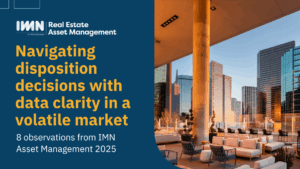Warehouses, multi- and single-tenant manufacturing, storage and distribution, and flex spaces are all driven by physical details. Yet too many asset management teams rely on reports that stop at occupancy and NOI, overlooking the factors that make a facility functional, marketable, or obsolete.
Clear height, column spacing, dock-door counts – all user-driven custom fields in Pereview – along with tenant rollover exposure are among the factors that determine how well your industrial assets perform. If you’re managing industrial portfolios, here are five reasons your current reporting may not be giving you the full picture, and how to close that gap.
1. Track the specs that drive leasing demand
Industrial leasing isn’t just about location or size – it’s about usability. Clear height, column spacing, and floor load capacity directly influence tenant fit and leasing velocity. Without this data, it’s nearly impossible to assess how competitive a facility really is.
Forward-looking asset managers are incorporating these specs into portfolio reviews, leasing strategy, and even Capex planning, giving them a sharper view of what drives absorption and long-term demand.
2. Treat dock doors as operational assets
The number and type of dock-high doors determine how quickly goods can move in and out, and how attractive a space is to logistics and manufacturing tenants. Despite this, many reporting tools still ignore this metric.
When dock counts are tracked alongside occupancy and tenant requirements, asset managers can better position properties in the market and anticipate when functional obsolescence may erode competitiveness.
3. Factor rollover risk into retention strategy
Leasing metrics like WAULT (weighted average unexpired lease term) and tenant exposure are just as critical as physical specs. Narrow rollover windows or concentrated rent streams can amplify risk, especially if the underlying facilities don’t meet evolving tenant needs.
Reporting that ties tenant rollover exposure to building specifications, such as column spacing or clear height, helps asset managers see where to prioritize renewals, negotiate incentives, or plan redevelopment.
4. Manage build-to-suit projects across the full lifecycle
Build-to-suit developments are often tracked in separate spreadsheets, making it difficult to connect delivery milestones, leasing outcomes, and long-term performance. That creates blind spots in forecasting and post-mortem analysis.
By pulling construction progress, leasing status, and stabilization metrics into one reporting framework, managers can compare build-to-suit facilities against underwriting and understand how customized space performs over time.
5. Connect specs, Capex, and NOI in one view
Too often, reporting systems capture either financials or physical characteristics, but not both. That makes it hard to answer strategic questions like:
- Do our 36-foot clear height warehouses outperform older 24-foot inventory?
- How does dock-door density correlate with tenant retention or rent growth?
- Where is Capex spend driving NOI and yield improvement?
The ability to combine specs, tenant data, and financial performance in one reporting environment is the key to identifying what’s really driving returns – and where reinvestment will have the greatest impact.
Bringing it all together
Industrial tenant expectations are being shaped by supply chain re-shoring, automation, and high-throughput logistics. In this environment, reporting that goes beyond NOI isn’t optional. It’s essential.
By unifying building specs, tenant rollover metrics, Capex and tenant improvement spend, and financial performance into one framework, asset managers can move past fragmented spreadsheets to real-time visibility. The result? Better decisions, smarter reinvestment, and stronger performance across warehouses, manufacturing plants, and flex space.



